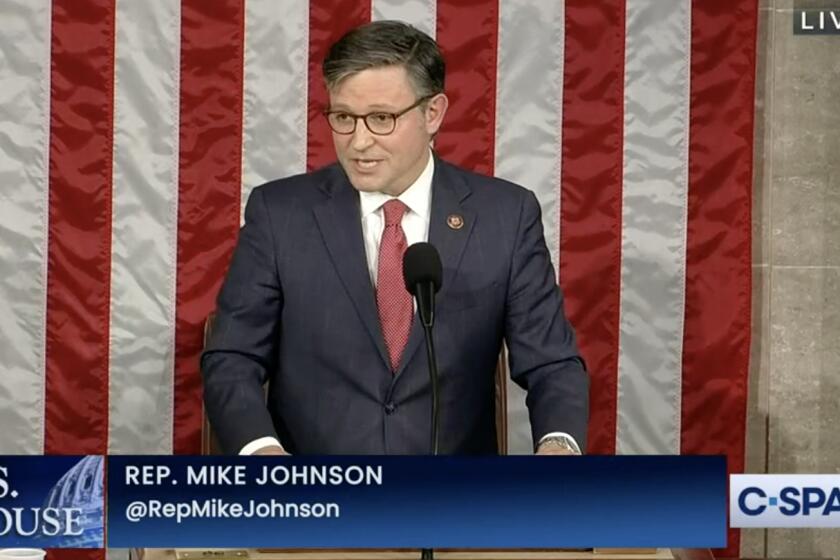Column: Trump pledges not to cut Social Security. Here are the ways he could breach that promise

- Share via
Despite all the talk about Donald Trump being a unique political figure in American history, there’s one way in which he has behaved like every other politician on the stump: He’s promised not to lay a hand on Social Security.
With more than 67 million Americans collecting stipends now and hundreds of millions more counting on benefits for their retirement, any threat to the system’s benefits sends a shudder through the nation’s workers. That’s why a promise not to cut benefits has become embedded into American politics for most of the program’s nine decades of existence.
But that hasn’t eliminated the threat of benefit cuts, chiefly from Republicans. Social Security’s internal workings are so recondite and poorly understood by average voters that numerous possible ways of imposing benefit cuts or otherwise harming the program are hiding in plain sight. Trump mentioned some during his recent presidential campaign and attempted others during his last term.
I’m not sure that this administration is going to be in the business of strengthening and protecting Social Security.
— Social Security Commissioner Martin O’Malley
Trump’s fellow Republicans have alluded to yet others. In March, the House GOP caucus released a budget proposal that would eviscerate Social Security.
The caucus members groused about how Social Security has expanded since it was originally signed into law by President Franklin Roosevelt in 1935, through “the addition of disability benefits, dependents and survivors benefits, and the incorporation of automatic cost-of-living adjustments.”
Get the latest from Michael Hiltzik
Commentary on economics and more from a Pulitzer Prize winner.
You may occasionally receive promotional content from the Los Angeles Times.
Predictably, they don’t mention who was responsible for these changes: Disability was added in 1956, under Dwight Eisenhower; cost-of-living adjustments were enacted in 1972, under Richard Nixon, and went into effect in 1975, under Gerald Ford. All three presidents were Republicans.
The committee called for “modest adjustments to the retirement age for future retirees to account for increases in life expectancy,” raising the retirement age to 69 from the current standard of 67 for new retirees. That’s a benefit cut, and one that would hit low-income and Black Americans harder than others.
Here’s the bottom line: It would be folly to be complacent about what the current political majority might do to Social Security.
Column: A conservative think tank says Trump policies would crater the economy — but it’s being kind
A conservative think tank’s estimate of the effect of Trump’s and Harris’ policies shows that a single-minded concern with the federal deficit makes no sense
“There’s a very serious worry on the horizon,” Social Security Commissioner Martin O’Malley told Al Sharpton on MSNBC last weekend, “because Donald Trump’s policies would seriously reduce the fiscal health of Social Security.... There’s a lot of talk among people around him about all sorts of gimmicks.” (O’Malley is leaving the commissioner’s post to run for the chairmanship of the Democratic National Committee.)
O’Malley is backed up by the Committee for a Responsible Federal Budget, a hive of conservative budget hawks.
Trump’s campaign proposals, the CRFB calculated in October, could cost Social Security’s cash reserves $1.3 trillion to $2.75 trillion over 10 years, hastening the exhaustion of its trust funds by three years, to 2031.
That would provoke a cut in benefits of as much as 33% if Congress fails to act in the interim, the committee reckoned — pointing to Trump’s proposals to eliminate taxes on Social Security benefits, impose across-the-board tariffs on imported goods and deport millions of immigrants.
Let’s take a look at the proposal Trump aired during the campaign to eliminate the federal income tax on Social Security benefits.
That’s a crowd-pleaser — after all, who doesn’t love lower taxes? It certainly would mean more take-home pay for those paying tax on their benefits, which is almost everyone except the lowest-income Americans. But it would erode the system’s fiscal stability at a crucial time. Trump couldn’t cut these taxes without congressional consent.
Social Security benefits are taxed on a progressive scale. Typically, couples with “combined income” of $32,000 to $44,000 are taxed on 50% of their benefits; those with more than $44,000 pay tax on up to 85% of their benefits. (For individuals, the first threshold is $25,000 to $34,000.)
Republicans want to cut Social Security benefits and protect the 1% from paying their share in taxes; Democrats know we can afford to raise benefits.
“Combined income” is defined as taxpayers’ adjusted gross income, plus their nontaxable interest earnings and half of their Social Security benefits.
Eliminating the tax on benefits, therefore, could put as much as $4,200 a year back in the pockets of an average benefit-collecting household. Those taxes, however, are paid back to the Social Security and Medicare systems.
For Social Security, which receives the tax on the first 50% of benefits, they’re vital to the program’s revenue stream —$50.7 billion, or 3.75% of all revenues, in 2023. Benefit taxation is projected to yield about $133 billion annually by 2033, accounting for more than 6.5% of the program’s income.
There are only two ways to keep Social Security whole — reduce benefits or increase the payroll tax that provides the largest chunk of income. Taxpayers would have to pay one way or another. And the joy of having more take-home pay now would evaporate when the bills start coming due.
During his first term, Trump and his acolytes took aim at Social Security’s disability insurance program, a favorite target of conservative Republicans. During an appearance on the CBS program “Face the Nation” in 2017, Trump’s budget director, Mick Mulvaney, led the charge.
“Do you really think that Social Security disability insurance is part of what people think of when they think of Social Security?” Mulvaney asked the moderator, John Dickerson. “I don’t think so. It’s the fastest-growing program. It grew tremendously under President Obama. It’s a very wasteful program, and we want to try and fix that.”
Dickerson did not push back. Eisenhower, a Republican, had added disability coverage to Social Security in 1956, six decades earlier. Not only was disability not the “fastest-growing program,” it had been shrinking — falling from a peak of 11 million beneficiaries, including disabled workers and their dependents, in 2013, to 10.4 million when Mulvaney was speaking; the rolls would continue to decline, falling to about 8.5 million in 2023.
The worst enemies of Social Security are would-be journalists who don’t do their homework before writing about it, and consequently get everything wrong.
As for the assertion that disability was “wasteful,” the truth was that the disability error rate, which counts both overpayments and underpayments to beneficiaries, was well below 1% of all benefits, then-acting Social Security Commissioner Carolyn Colvin advised Congress in 2012.
Trump advanced the attack on disability through his 2020 budget, which aimed to cut disability benefits by $70 billion over a decade. Mulvaney even bragged about hoodwinking Trump into violating his promise not to cut Social Security by telling him the cuts would be in “disability insurance” without revealing that disability insurance is part of Social Security.
Republicans consistently slander disability recipients as malingerers and layabouts. That’s based on the groundless notion that disability is easy to apply for and receive.
The disability certification process is long and difficult. Applicants must show that they have a physical or mental condition that prevents them from earning even $1,550 a month, or $18,600 a year, on their own. The approval process can take months, and even after appeals, only about 40% of applicants end up with benefits.
What’s important about the attacks on disability in Trump’s first term is that claims tend to rise along with the unemployment rate. The reason is that as job opportunities decline in general, the jobs available to the disabled become especially scarce. When desk jobs disappear and all that’s left are laborers’ positions, the opportunities for the physically and mentally challenged become only more limited.
That could be a factor if Trump’s economic policies, such as his intention to jack up tariffs on all imported goods, produce a recession. If that happens, keep your eye on the palaver about disability; it’s almost certain to experience a resurgence.
One tried-and-true method of undermining Social Security is starving the program of administrative resources, a GOP hobby horse for years. “Social Security, today, is serving more customers than ever before with staffing levels Congress has reduced to 50-year lows,” O’Malley told the House Appropriations Committee earlier this month.
The consequences have included wait times on the program’s 800 number that ballooned to nearly an hour, O’Malley said. Of the average 7 million clients who called the number each month for advice or assistance, 4 million “hung up in frustration after waiting far too long.”
The backlog of initial disability determinations reached a near-record of 1.2 million applicants awaiting a decision, some for more than a year. The program estimated that about 30,000 applicants died in 2023 while awaiting decisions.
America’s retirement system is already among the worst in the developed world. If new House Speaker Mike Johnson were to get his way, it would be far worse.
The crisis in customer service matters because it erodes public confidence that the program will be there for them when their turn comes to claim benefits.
Then there’s Trump’s threat to deport as many as 11 million undocumented immigrants. An estimated 8.3 million unauthorized residents are part of the U.S. labor force. Social Security’s dirty little secret is that those who are working are actually improving the program’s fiscal health. That’s because they often submit falsified Social Security numbers to employers, so payroll taxes are withheld from their earnings — but because they don’t have legal Social Security numbers they can never collect benefits.
Furthermore, the mass deportations Trump has promised are likely to debilitate local and state economies. With the laborers needed to pick crops and build houses disappearing, those industries could stagnate, throwing native-born jobholders out of work. Less money will be coming into Social Security’s coffers. The overall loss to the program could be $300 billion to $1 trillion over a decade, the CRFB estimated.
The most dire prospect for Social Security in the coming term may be indifference to its future. Under a Democratic administration and with Democratic majorities in Congress, the prospects were good for the advancement of proposals to broaden and expand Social Security benefits.
Will anything like that happen in Trump’s next term? O’Malley tried to be judicious during his MSNBC appearance, but his opinion was clear: “I’m not sure,” he said, “that this administration is going to be in the business of strengthening and protecting Social Security.”
More to Read
Get the latest from Michael Hiltzik
Commentary on economics and more from a Pulitzer Prize winner.
You may occasionally receive promotional content from the Los Angeles Times.















